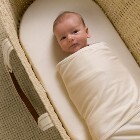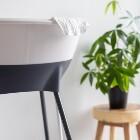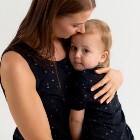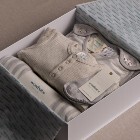In its updated policy statement outlining recommendations to prevent Sudden Infant Death Syndrome (SIDS), the American Academy of Pediatrics (AAP) writes that SIDS continues to be a phenomenon of unknown cause and, despite marked reductions in rates over the past decade, still is responsible for more infant deaths in the United States than any other cause of death during infancy beyond the neonatal period. Titled “The Changing Concept of Sudden Infant Death Syndrome: Diagnostic Coding Shifts, Controversies Regarding the Sleeping Environment, and New Variables to Consider in Reducing Risk,” the document addresses several issues that have become relevant since the AAP last published a statement in 2000.
The AAP no longer recognizes side sleeping as a reasonable alternative to fully supine (lying on back) sleeping. Studies have found that the side sleep position is unstable and increases the chances of the infant rolling onto his or her stomach. Every caregiver should use the back sleep position during every sleep period.
Bed sharing is not recommended during sleep. Infants may be brought into bed for nursing or comforting, but should be returned to their own crib or bassinet when the parent is ready to return to sleep. However, there is growing evidence that room sharing (infant sleeping in a crib in parent’s bedroom) is associated with a reduced risk of SIDS. The AAP recommends a separate but proximate sleeping environment.
Research now indicates an association between pacifier use and a reduced risk of SIDS, which is why the revised statement recommends the use of pacifiers at nap time and bedtime throughout the first year of life. The evidence that pacifier use inhibits breastfeeding or causes later dental complications is not compelling enough to discredit the recommendation. However, it is recommended that pacifier introduction for breastfed infants be delayed until one month of age to ensure that breastfeeding is firmly established. In addition, if the infant refuses the pacifier, it should not be forced. There is a slight increased risk of ear infections associated with pacifier use, but the incidence of ear infection is generally lower in the first year of life, especially the first six months, when the risk of SIDS is the highest.
The following have been consistently identified as risk factors for SIDS: prone (lying on stomach) sleep position, sleeping on a soft surface, maternal smoking during pregnancy, overheating, late or no prenatal care, young maternal age, preterm birth and/or low birth weight and male gender. Consistently higher rates of SIDS are found in African American and American Indian/Alaska Native children—two to three times the national average.
The new AAP policy recommendations include:
-
Back to sleep: Infants should be placed for sleep in a supine (wholly on back position) for every sleep.
-
Use a firm sleep surface: A firm crib mattress, covered by a sheet, is the recommended sleeping surface.
-
A separate but proximate sleeping environment is recommended: Such as a separate crib in the parent’s bedroom. Bed sharing during sleep is not recommended.
-
Keep soft objects and loose bedding out of the crib: Pillows, quilts, comforters, sheepskins, stuffed toys and other soft objects should be kept out of an infant’s sleeping environment.
-
Do not smoke during pregnancy: Also, avoiding an infant’s exposure to second-hand smoke is advisable for numerous reasons in addition to SIDS risk.
-
Consider offering a pacifier at nap time and bedtime: The pacifier should be used when placing infant down for sleep and not be reinserted once the infant falls asleep.
-
Avoid overheating: The infant should be lightly clothed for sleep, and the bedroom temperature should be kept comfortable for a lightly clothed adult.
-
Avoid commercial devices marketed to reduce the risk of SIDS: Although various devices have been developed to maintain sleep position or reduce the risk of rebreathing, none have been tested sufficiently to show efficacy or safety.
-
Do not use home monitors as a strategy to reduce the risk of SIDS: There is no evidence that use of such home monitors decreases the risk of SIDS.
-
Avoid development of positional plagiocephaly (flat back of head): Encourage “tummy time.”
-
Avoid having the infant spend excessive time in car-seat carriers and “bouncers”: Place the infant to sleep with the head to one side for a week and then change to the other.
-
Ensure that others caring for the infant (child care provider, relative, friend, babysitter) are aware of these recommendations.























